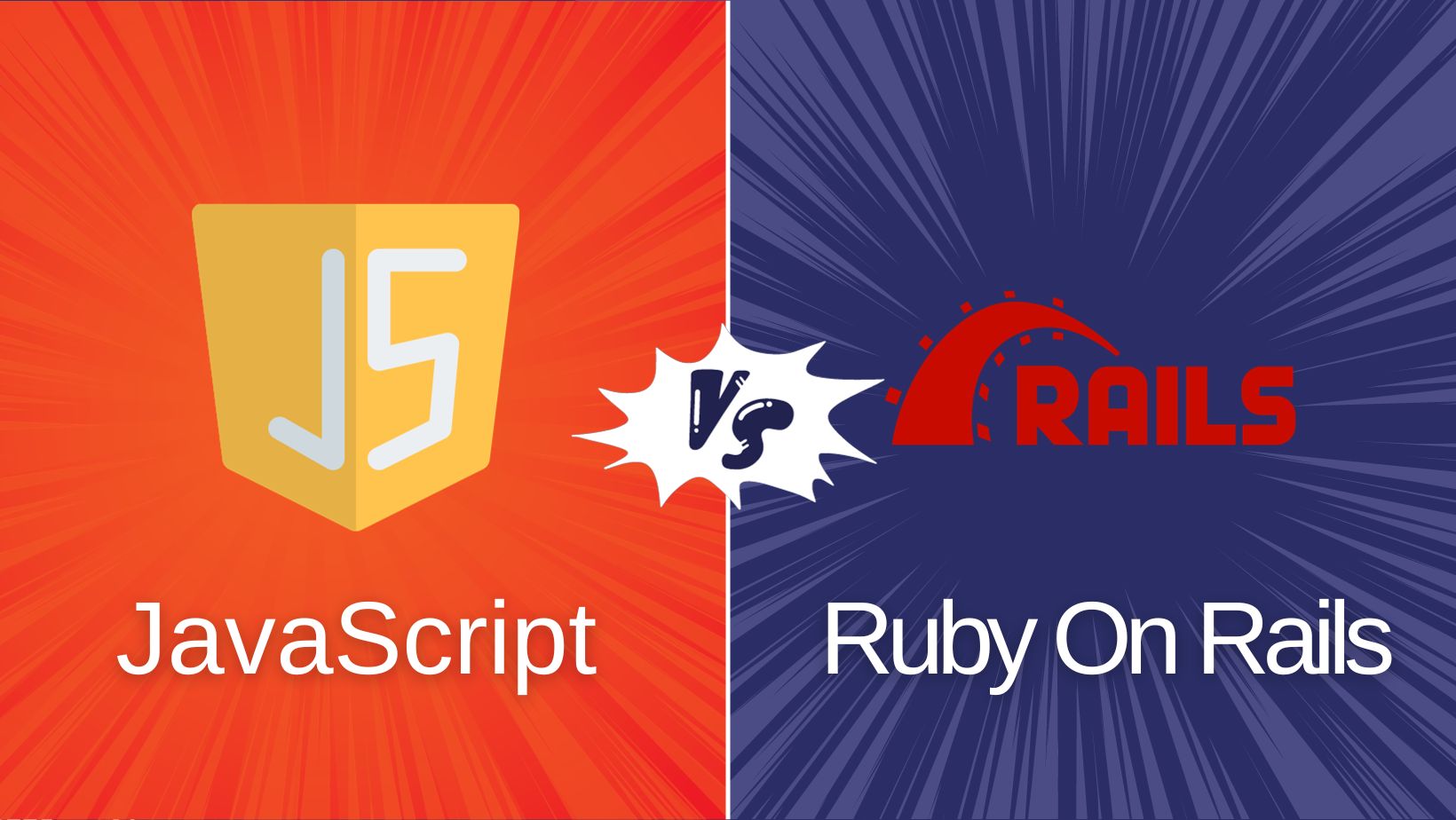To create dependable and expandable applications in the dynamic field of web development, selecting the appropriate framework is essential. Two popular contenders in this realm are JavaScript and Ruby on Rails. Ruby on Rails is a full-stack online application framework, whereas JavaScript is a flexible programming language frequently used for front-end development. To assist developers in making an educated choice, we will thoroughly compare the capabilities, benefits, and use cases of both frameworks.
Overview of JavaScript and Ruby on Rails
Introduction to JavaScript
-
Brief history: JavaScript, born in 1995, initially served to add interactivity to web pages. Today, it’s a versatile scripting language, widely used for both client and server-side development.
-
Use cases and popularity: JavaScript dominates front-end web development and, with the advent of Node.js, has expanded into server-side development, gaining immense popularity and a robust community.
Introduction to Ruby on Rails
-
Brief history: Conceived in 2004 by David Heinemeier Hansson, Ruby on Rails (Rails) is a full-stack web application framework, known for its convention over configuration approach.
-
Key characteristics and popularity: Ruby on Rails is celebrated for its elegant syntax, adherence to best practices, and its popularity in startups and small to medium-sized projects.
Language Characteristics and Syntax
JavaScript
-
Dynamic typing: JavaScript’s dynamic typing allows flexible variable assignments but introduces challenges in maintaining type consistency.
-
Prototypal inheritance: JavaScript utilizes prototypal inheritance, a unique approach where objects inherit properties directly from other objects.
-
Asynchronous programming with callbacks and promises: Asynchronous programming using callbacks and promises enables non-blocking execution, which is crucial for tasks like handling user input and making API calls.
Ruby on Rails
-
Dynamic typing: Ruby on Rails shares dynamic typing with JavaScript but places a strong emphasis on code readability and developer-friendly syntax.
-
Object-oriented programming: Ruby’s inherent object-oriented nature is leveraged in Rails, encouraging clean, modular, and reusable code.
-
Convention over Configuration (CoC): Rails adopts the CoC principle, reducing explicit configuration needs and enhancing developer productivity.
Development Environment and Tools
JavaScript
-
Browser-based development: Traditionally associated with browser-based development, JavaScript now spans server-side development with Node.js.
-
Node.js and npm for server-side development: Node.js enables server-side development, while npm simplifies package management, fostering a robust ecosystem.
-
Popular JavaScript Frameworks (React, Angular, Vue): JavaScript’s rich ecosystem includes popular front-end frameworks like React, Angular, and Vue, each catering to different development preferences.
Ruby on Rails
-
Integrated Development Environment: Rails is often associated with integrated development environments (IDEs) like RubyMine and Visual Studio Code, enhancing developer efficiency.
-
Built-in testing tools: Rails provides built-in testing tools, promoting the creation of robust and maintainable code.
-
Gems and the RubyGems package manager: Ruby on Rails relies on gems and the RubyGems package manager to extend functionality and simplify management. This format continues similarly for the remaining sections. If you’d like to continue or make specific modifications, feel free to let me know!
Architecture and Framework Design
JavaScript
-
Client-side frameworks (React, Angular, Vue): JavaScript excels in client-side frameworks like React, Angular, and Vue. React, for instance, adopts a component-based architecture, while Vue emphasizes simplicity.
-
Server-side frameworks (Express, Nest.js): For server-side development, Express is a popular choice in the JavaScript ecosystem. Nest.js, built on Express, offers a more structured approach with TypeScript and object-oriented programming.
Ruby on Rails
-
Model-View-Controller (MVC) architecture: Ruby on Rails adheres to the MVC architecture, providing a structured approach with Models, Views, and Controllers for enhanced code organization and maintainability.
-
Convention over Configuration (CoC) and Don’t Repeat Yourself (DRY) principles: Rails emphasizes CoC and the DRY principle, promoting minimal configuration and reducing code duplication. This leads to concise, readable, and maintainable code.
Database Integration
JavaScript
-
MongoDB and NoSQL databases: JavaScript, especially with Node.js, is often associated with NoSQL databases like MongoDB, offering flexibility aligned with JavaScript’s dynamic nature.
-
MySQL, PostgreSQL, and other relational databases: JavaScript seamlessly integrates with relational databases such as MySQL and PostgreSQL, providing developers the flexibility to choose based on project requirements.
Ruby on Rails
-
ActiveRecord for Database Interactions: Ruby on Rails employs ActiveRecord, an Object-Relational Mapping (ORM) system that simplifies database interactions, allowing developers to interact with databases using Ruby.
-
Support for various databases including MySQL and PostgreSQL: Rails natively supports multiple databases, including popular choices like MySQL and PostgreSQL, providing flexibility to match project needs.
Scalability and Performance
JavaScript
-
Scaling challenges in traditional server-side JavaScript: Traditional server-side JavaScript faced scalability challenges due to its single-threaded nature. However, the advent of asynchronous programming and technologies like Node.js has addressed some of these challenges, allowing for better scalability.
-
Asynchronous programming for improved performance: Asynchronous programming in JavaScript, especially with features like async/await, enhances performance by allowing non-blocking execution, crucial for handling concurrent tasks efficiently.
Community Support and Ecosystem
JavaScript
-
Vibrant and diverse community: JavaScript boasts a vibrant and diverse community that actively contributes to its growth. With a multitude of developers worldwide, there’s a wealth of knowledge-sharing and collaboration.
-
Extensive ecosystem of libraries and tools: The JavaScript ecosystem is expansive, featuring a plethora of libraries and tools. This diversity allows developers to choose the best-suited technologies for their projects, contributing to the adaptability of JavaScript.
Ruby on Rails
-
Strong and supportive community: Ruby on Rails has a strong and supportive community that values collaboration and sharing. This community-driven approach enhances the framework’s development and maintenance.
- Rich ecosystem with a focus on convention and productivity: Rails prioritizes convention over complex setups. A gem-rich ecosystem and focus on reliable app construction make development efficient, not just fast.
Learning Curve and Documentation
JavaScript
-
Learning resources and documentation: JavaScript offers a plethora of learning resources, including tutorials, documentation, and online courses. However, the dynamic nature of the language and the multitude of frameworks can present challenges for beginners.
-
Challenges for Beginners: The sheer breadth of JavaScript and its diverse ecosystem can overwhelm beginners. Navigating the multitude of frameworks and libraries may require extra effort for those new to the language.
Ruby on Rails
Comprehensive documentation and guides: Ruby on Rails provides comprehensive documentation and guides that facilitate smooth onboarding. The convention-driven nature of Rails can accelerate the learning curve for developers.
Initial learning curve and ongoing productivity: While Rails’ conventions can simplify the learning process, mastering all its aspects may take some time. However, once developers become familiar with the conventions, ongoing productivity tends to increase.
Use Cases and Industry Adoption
JavaScript
Front-end development in web browsers: Rules web browsers, making interfaces interactive and dynamic.
Mobile app development with frameworks like React Native: Frameworks like React Native let you build mobile apps with JavaScript’s power.
Ruby on Rails
Full-stack web application development: Build entire web applications, front-end to back-end, with one powerful framework.
Examples of successful applications built with Ruby on Rails: Basecamp, GitHub, and Shopify – these giants run on Ruby on Rails, making it a winner in the real world.
Conclusion
Summary of key differences and similarities
In summary, JavaScript and Ruby on Rails are powerful tools catering to different aspects of web development. JavaScript is a versatile language, prominently used for front-end development and increasingly gaining ground in server-side applications with frameworks like Node.js. Ruby on Rails, on the other hand, offers a full-stack framework with a focus on convention over configuration, promoting rapid development.
While JavaScript is known for its dynamic nature and asynchronous capabilities, Ruby on Rails stands out for its elegant syntax, MVC architecture, and DRY principle. Both have extensive ecosystems, vibrant communities, and successful use cases in various industries.



